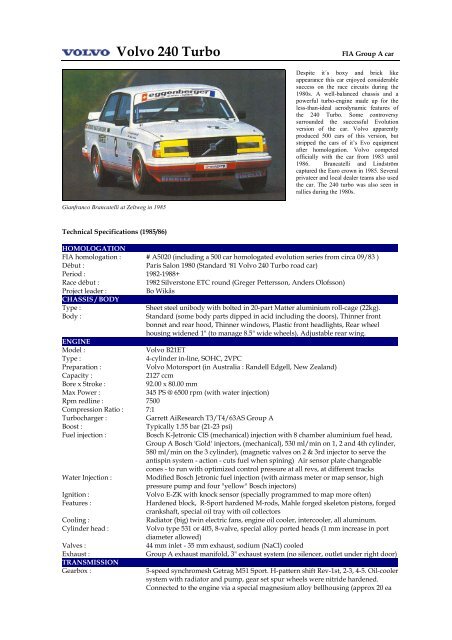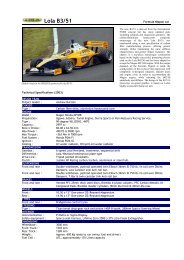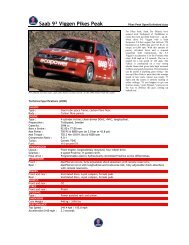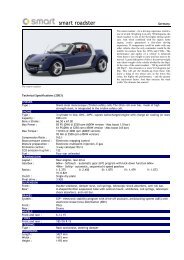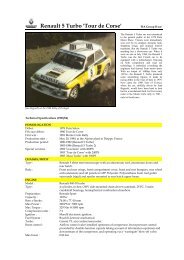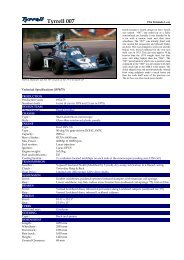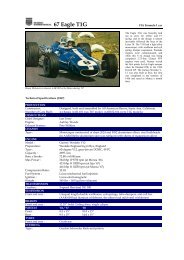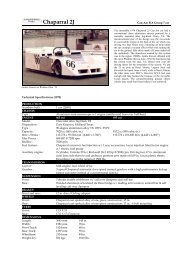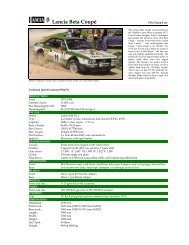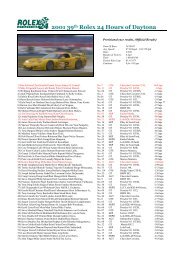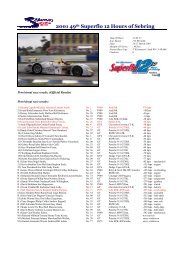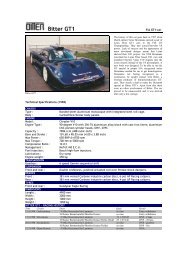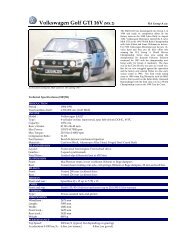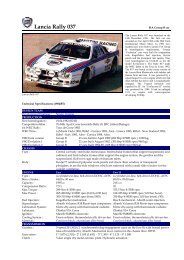85 Volvo 240 Turbo - Motorsports Almanac
85 Volvo 240 Turbo - Motorsports Almanac
85 Volvo 240 Turbo - Motorsports Almanac
Create successful ePaper yourself
Turn your PDF publications into a flip-book with our unique Google optimized e-Paper software.
Gianfranco Brancatelli at Zeltweg in 19<strong>85</strong><br />
Technical Specifications (19<strong>85</strong>/86)<br />
<strong>Volvo</strong> <strong>240</strong> <strong>Turbo</strong> FIA Group A car<br />
Despite it´s boxy and brick like<br />
appearance this car enjoyed considerable<br />
success on the race circuits during the<br />
1980s. A well-balanced chassis and a<br />
powerful turbo-engine made up for the<br />
less-than-ideal aerodynamic features of<br />
the <strong>240</strong> <strong>Turbo</strong>. Some controversy<br />
surrounded the successful Evolution<br />
version of the car. <strong>Volvo</strong> apparently<br />
produced 500 cars of this version, but<br />
stripped the cars of it’s Evo equipment<br />
after homologation. <strong>Volvo</strong> competed<br />
officially with the car from 1983 until<br />
1986. Brancatelli and Lindström<br />
captured the Euro crown in 19<strong>85</strong>. Several<br />
privateer and local dealer teams also used<br />
the car. The <strong>240</strong> turbo was also seen in<br />
rallies during the 1980s.<br />
HOMOLOGATION<br />
FIA homologation : # A5020 (including a 500 car homologated evolution series from circa 09/83 )<br />
Début : Paris Salon 1980 (Standard '81 <strong>Volvo</strong> <strong>240</strong> <strong>Turbo</strong> road car)<br />
Period : 1982-1988+<br />
Race début : 1982 Silverstone ETC round (Greger Pettersson, Anders Olofsson)<br />
Project leader : Bo Wikås<br />
CHASSIS / BODY<br />
Type : Sheet steel unibody with bolted in 20-part Matter aluminium roll-cage (22kg).<br />
Body : Standard (some body parts dipped in acid including the doors), Thinner front<br />
bonnet and rear hood, Thinner windows, Plastic front headlights, Rear wheel<br />
housing widened 1" (to manage 8.5" wide wheels), Adjustable rear wing.<br />
ENGINE<br />
Model : <strong>Volvo</strong> B21ET<br />
Type : 4-cylinder in-line, SOHC, 2VPC<br />
Preparation : <strong>Volvo</strong> Motorsport (in Australia : Randell Edgell, New Zealand)<br />
Capacity : 2127 ccm<br />
Bore x Stroke : 92.00 x 80.00 mm<br />
Max Power : 345 PS @ 6500 rpm (with water injection)<br />
Rpm redline : 7500<br />
Compression Ratio : 7:1<br />
<strong>Turbo</strong>charger : Garrett AiResearch T3/T4/63AS Group A<br />
Boost : Typically 1.55 bar (21-23 psi)<br />
Fuel injection : Bosch K-Jetronic CIS (mechanical) injection with 8 chamber aluminium fuel head,<br />
Group A Bosch 'Gold' injectors, (mechanical), 530 ml/min on 1, 2 and 4th cylinder,<br />
580 ml/min on the 3 cylinder), (magnetic valves on 2 & 3rd injector to serve the<br />
antispin system - action - cuts fuel when spining) Air sensor plate changeable<br />
cones - to run with optimized control pressure at all revs, at different tracks<br />
Water Injection : Modified Bosch Jetronic fuel injection (with airmass meter or map sensor, high<br />
pressure pump and four "yellow" Bosch injectors)<br />
Ignition : <strong>Volvo</strong> E-ZK with knock sensor (specially programmed to map more often)<br />
Features : Hardened block, R-Sport hardened M-rods, Mahle forged skeleton pistons, forged<br />
crankshaft, special oil tray with oil collectors<br />
Cooling : Radiator (big) twin electric fans, engine oil cooler, intercooler, all aluminum.<br />
Cylinder head : <strong>Volvo</strong> type 531 or 405, 8-valve, special alloy ported heads (1 mm increase in port<br />
diameter allowed)<br />
Valves : 44 mm inlet - 35 mm exhaust, sodium (NaCl) cooled<br />
Exhaust : Group A exhaust manifold, 3" exhaust system (no silencer, outlet under right door)<br />
TRANSMISSION<br />
Gearbox : 5-speed synchromesh Getrag M51 Sport. H-pattern shift Rev-1st, 2-3, 4-5. Oil-cooler<br />
system with radiator and pump, gear set spur wheels were nitride hardened.<br />
Connected to the engine via a special magnesium alloy bellhousing (approx 20 ea
made)<br />
Ratios : I : 2.328:1<br />
II : 1.675:1<br />
III : 1.353:1<br />
IV : 1.145:1<br />
V : 1.000:1<br />
Clutch : AP metal sintered, hydraulically actuated<br />
Rear Axle : Alloy housing (two types) 1031 with bolt on tubes, steel (two types) with 1.5 degree<br />
negative camber + sensors for antispin system. Later development was lightweight<br />
carbon-fibre unit. Special drive shafts for negative camber and wheel center hub<br />
bolting system (left and right threads). Axle centre fitted with oil cooling system -<br />
pump and radiator.<br />
Final drive : Dana or ZF Limited slip diff. Gearing ratios 2.86, 3.15, 3.31, 3.73, 3.91, 4.10, 4.56,<br />
4.88.<br />
SUSPENSION<br />
Front : Bilstein short adjustable spring struts, VMS adjustable alloy A- arms, anti-roll bar.<br />
Rear : Steel or aluminum lower support arms, adjustable upper control arms adjustable<br />
panhard rod, Bilstein shockdampers, anti-roll bar.<br />
BRAKES<br />
Front : 330 mm ventilated discs with AP or Brembo alloy calipers<br />
Rear : 280 mm ventilated discs with AP or Brembo alloy calipers<br />
STEERING<br />
Type : Power-assisted rack-and-pinion - 2.6 or 3.5 turns.<br />
WHEELS<br />
Front and rear : 8 x 16" or 9 x 17" BBS, Compomotive, Ronal or Speedline - 90 mm center hub<br />
attachment, split or mono wheels.<br />
TIRES<br />
Front : Pirelli P7 25/62VR17 (Pirelli D3 was used in '86)<br />
Rear : Pirelli P7 26/64VR17 (Pirelli D3 was used in '86)<br />
(8 1/2" x 16" Avons in Australia)<br />
DIMENSIONS<br />
Wheelbase : 2640 mm<br />
Length : 4790 mm<br />
Width : 1710 mm<br />
Weight : Bit over class minimum of 1065 kg<br />
Fuel cell : 120 litre safety tank with 8-bar quick fill system.<br />
VOLVO <strong>240</strong> TURBO HISTORY<br />
In order to compete in group-A, <strong>Volvo</strong> Motorsport had to built atleast 500 "homologation" cars. So, in 1983 242<br />
"evolution" was brought to the market. All the cars were sold in the USA though few found their ways back to<br />
Sweden. All the cars had european front and so-called "flathood", even though they were mainly sold in the<br />
USA. There are also lots of other differences, such as the engine: B21 with modified 405 cylinder head, group-A<br />
type cam ("generation 1"), group-A turbo, group-A, intake manifold with "Bosch Gold" injectors, group-A<br />
exhaust manifold, special airmassmeter for use with water injection, group-a aluminum intercooler etc. Boost<br />
was set at 1.05bar and the output was very nice 225hp @ 5700 rpm and 340Nm @ 3300rpm! As usual for<br />
homologation specials, rumours exixted that only a small amount of the 500 cars had these parts installed and<br />
the rest were just original 242 turbos. The gearbox was surprisingly a M46, though it had aluminum housing<br />
and it's modified in other ways too (higher oil pressure, "fast shift" etc.). Also, a five-speed Getrag was<br />
available through special order. Clutch was ofcourse enforced and rear axle was the legendary "Dana 30" 1031<br />
with limited slip differential. Suspension featured <strong>Volvo</strong> Motorsport springs and "<strong>Volvo</strong> sport" shocks (made<br />
by DeCarbon). Bushings were harder ones and anti-sway bars are the same as in original turbo versions. The<br />
car came with different wheel choices to suit the buyers needs, from original 6x15" Virgo to 9x17" (without a<br />
doubt the most amazing looking wheel, 9x17" 3-piece split wheel made by BBS. Rare and *expensive*.). The<br />
interior was usually black leather with extra gauges and <strong>Volvo</strong>'s "sport" steering wheel. These cars are indeed<br />
rare and valuable collectors items, if you find one in original shape and with the gr-A type parts, don't hesitate<br />
to buy it!<br />
1983 FIA GROUP A HOMOLOGATED 242 TURBO by Steve Seekins VCOA<br />
This two-door 242 series car arrived in the dealerships in 1983 as a result of the need to manufacture a<br />
minimum number of cars to qualify them for racing in a production class. One of the enigmas about these cars<br />
is exactly what differences there were from the rest of the <strong>240</strong> series turbos. It seems that everyone has a<br />
different answer. The question often elicits just a clandestine smile from <strong>Volvo</strong> Corporation types, however, I<br />
have been able to piece together a few interesting items. These cars were fitted with a B21ET engine in place of<br />
the B21FT installed in other cars. The ET version was the European version of the turbo engine and provided<br />
some extra power over the FT. I am guessing, but I suspect that these engines were fitted with slightly different
pistons and other internal parts as well, because they were intended to be used for racing with a different<br />
manifold and the larger T04 Garrett turbocharger. I have heard, but cannot be certain, that they may be<br />
equipped with larger clutches and lightened flywheels. Thirty of the cars were returned to Sweden for racing<br />
after being imported to the US. These cars were fitted with other items besides the larger turbos. Included in<br />
the list are <strong>Volvo</strong> Electronic Water Injection Systems with an eight gallon tank, Getrag five-speed gearbox,<br />
limited slip differential, ventilated disc brakes on all four wheels with aluminum AP-Lockheed four piston<br />
calipers, adjustable front/rear brace balance, magnesium alloy wheels (8.5/8.75x16") with center lock nut and<br />
Pirelli P7 245/45 VR16 tires. Final drive ratios were available ranging from 1:4.56 to 1:3.15. The car also had a<br />
31 gallon fuel tank. For instrumentation, the racing cars were equipped with full digital instruments. These<br />
were vertical stacks of green, orange and red lights. Although the US drivers have indicated a preference for<br />
the analog type gauges, the European racing drivers said this digital arrangement worked very well for them<br />
since all they needed to know was that the system was performing properly, marginally, or had failed. The xray<br />
picture also shows the special lightweight alloy roll cage that was installed for racing (not legal in the US),<br />
the four corner pneumatic jacks, trunk mounted battery, extra bracing for the front shock towers, and the rear<br />
spoiler. These rear spoilers were reputedly supplied with all cars, unmounted in the trunk. I don't recall seeing<br />
any of them, so I wonder what happened to them? Oh, and by the way the engine with all the goodies on it<br />
develops 340 HP at 6600 RPM and 310 ft/lbs. of torque at 4000 to 5000 RPM and will power the car to speeds<br />
over 150 MPH.<br />
HOW THE 1983 "FLATHOODS" WERE CAME TO BE by Duncan LaBay VCOA<br />
In the last issue, I mentioned the very rare 1983 "flat-hood" 242 Group-A <strong>Turbo</strong>s. <strong>Volvo</strong> manufactured 500 of<br />
these cars to meet production requirements for Group-A sedan class racing in Europe. Some number of them<br />
were sold to private customers in the US through the <strong>Volvo</strong> dealer network. Different sources tell different<br />
stories about the distribution of these vehicles. According to various US sources, all 500 were brought to the<br />
United States through Portsmouth, Virginia port of entry. Some 30 were then sent back to Europe for racing. In<br />
racing trim, the cars had bigger (T04) turbo, water injection, a different intake manifold, four wheel vented disc<br />
brakes, full digital instrumentation, light alloy roll cages, and different front struts. The vehicles which stayed<br />
in the US were changed back to standard 1983 <strong>Turbo</strong> specs in these areas, although the Group-A <strong>Turbo</strong>s sold<br />
here did retain the GT springs, a factory intercooler, and the 242-style European front end sheetmetal.<br />
Although <strong>Volvo</strong> Cars of North America spokespeople indicate the Group-A <strong>Turbo</strong> has the standard 161 HP<br />
turbo output, those who have driven these cars all say they are definitely faster than a stock turbo with an<br />
intercooler added. Supposedly, all Group-A <strong>Turbo</strong>s sold in the US came through with manual sunroofs, while<br />
the European racing cars did not have sunroofs. One unconfirmed source suggests 312 of the 500 vehicles had<br />
4-speed manual plus overdrive transmissions, with the balance being automatics. The vehicles were produced<br />
in a variety of colors, although metallic blue, metallic silver and black seem to be the most common in the US.<br />
Information on the Group-A <strong>Turbo</strong>s is scarce and conflicting. Any club member who has one of these cars is<br />
encouraged to check the VIN and VIC plates, and let me know of any discrepancies from the information<br />
shown here. (An article from ROLLING the VCOA's bi-monthly magazine. Vol. 9 No. 3 May/June 1991)<br />
'ONE HOT LAP' with Ulf Granberg in a <strong>240</strong> <strong>Turbo</strong> Group A by Angus MacKenzie<br />
MONZA Race Circuit - Italy 1986 - We flashed past Monza's pit lane. The tacho's showing 7,000 rpm, the<br />
turbo boost gauge is reading 1.4 bar (20.5 psi). That means over 250 km/h and we've just shot past the 200<br />
metre braking marker at the first chicane. Not 10 minutes earlier European Touring Car Champion Thomas<br />
Lindstrom had driven slowly around the fast 5.8 km Monza circuit and carefully explained the breaking and<br />
gearchange points. "Keep right and brake at 200 metres," he said as we dawdled into Monza's first chicane in<br />
<strong>Volvo</strong> 740 <strong>Turbo</strong> Estate. So even as team-mate Ulf Granberg, now chauffeuring me in the works <strong>Volvo</strong> <strong>240</strong>T<br />
Group A race car, finally mashed the brake pedal at the 150 metre mark, I knew he was having a big go. The<br />
full harness bites into my shoulders as the <strong>Volvo</strong> squirms under brakes. Bam! Bam! Bam! Granberg heels and<br />
toes back to second gear with machine gun rapidity, swinging the suede covered Momo steering wheel hard<br />
left into the first part of the chicane. Even as we bounce off the kerbing, Granberg dabs at the throttle and<br />
throws the <strong>Volvo</strong> to the right, up and over the kerb. Suddenly the <strong>240</strong>T spits sideways - simultaneously<br />
Granberg grabs an armful of opposite lock and boots the accelerator. He brings the car back onto line by the<br />
scruff of its neck. We jumped the kerbs again on the second left-right kink of the chicane then on the gas hard -<br />
third, fourth, fifth - into the Curva Grande. He feathers the throttle through the long sweeping right hander,<br />
the <strong>Volvo</strong>'s inside wheels lifting as we delicately walk the tight-rope between under and oversteer. Past the<br />
clipping point and hard on the throttle again as we scream down toward the second chicane. Granberg stands<br />
on the brakes as we flash under the Campari bridge, rapid fire again back to second gear as he steadies the<br />
<strong>Volvo</strong> for the single left-right flick ahead. We bounce the kerbs again and it's full-bore into the double apex<br />
Curve di Lesmo. We charge through the first Lesmo flat in third, then Granberg grabs fourth as we slide up<br />
onto the kerbing in readiness for the second Lesmo. Again the <strong>Volvo</strong> corkscrews as the outside tyres bite and<br />
the inside wheels lift clear of the tarmac. We run wide up onto the kerbing again - "You must use all the track"<br />
as Granberg grabs fifth through the gentle left hand kink on the run down to the Variante Ascari. We're flat in<br />
fifth as the track dips under Monza's huge banked oval. The Variante Ascari, named after the great Italian<br />
World Champion killed there while testing in 1955, is the fastest of Monza's three chicanes. Granberg hauls the<br />
<strong>Volvo</strong> back from just on 250 km/h and downshifts twice. We're over the kerb on the first left hander but the
left hand wheels are in the air so there's no shock through the suspension. A stab on the throttle and then<br />
through the next right-left wiggle, Granberg sawing at the wheel as the car drifts from kerb to kerb. Full bore,<br />
full boost and 340 bhp hurls us down the short straight towards the Parabolica. It's tight, deceptively tight - at<br />
first we seem to be travelling way too quickly - but Granberg clips the inside kerb clearly and lets the <strong>Volvo</strong><br />
run wide for the run onto the main straight. Get the Parabolica right and you'll be quick all the way down the<br />
main straight. Get it wrong... The brilliant Austrian Jochen Rindt died here in his Lotus in 1970. He was<br />
posthumously awarded the World Championship. Granberg brings the <strong>Volvo</strong> into the pit lane at a brisk clip.<br />
The stop watches confirm we've lapped within a second or two of race pace. Full face helmets, the brap-brap of<br />
the exhaust and the howl of the drive train make conversation impossible, but Granberg, the Swedish train<br />
driver who led yesterday's first round of the European Touring Car Championship until a head gasket blew on<br />
the <strong>Volvo</strong>, turns and lifts his eyebrow quizzically. My thumbs up sign is returned with a nod.<br />
THE GROUP A VOLVO <strong>240</strong> TURBO IN AUSTRALIA by Anthony Hyde<br />
1984 - The Belgium <strong>Volvo</strong> Dealer Team ran the LH drive semi-works built GpA in the1984 European<br />
championship season. The car was shipped to New Zealand after the season finished, purchased by Mark<br />
Petch a NZ engineer/businessman/race car driver. Petch formed a race team partnership with driver Robbie<br />
Francevic, and were the only privateers in the world running a GpA <strong>240</strong> without works support.<br />
19<strong>85</strong> - In January, Mark Petch Racing won the famous Wellington 500 street race in NZ, starting from rear of<br />
grid, with drivers R.Francevic, and Belgian, Michel Delcourt. Soon after in 19<strong>85</strong> the car was shipped to<br />
Australia, being a late entry into the Australian Touring Car Championship where it performed very well.<br />
Later in the year it competed at Bathurst in the James Hardie 1000.<br />
1986 - The car was sold to '<strong>Volvo</strong> Australia', and ran under the '<strong>Volvo</strong> Dealer Team' banner. The consortium<br />
comprised of Valvoline Australia, Australian & New Zealand <strong>Volvo</strong> Dealers (who contributed 40% to the race<br />
budget), Mark Petch Motorsport, and other sponsors. Technical support was provided by the <strong>Volvo</strong><br />
Motorsport Dept. in Sweden. The first debut of the <strong>Volvo</strong> Dealer Teams' 2nd GpA <strong>240</strong>T (RH drive) was at<br />
Adelaide International Raceway in April 1986 where it came in 4th - driver John Bowe. This 2nd car was<br />
originally the Factory Euro test car, being fully rebuilt by the Factory before shipment to Oz. In May 1986,<br />
Robbie Francevic took over the RH drive car and John Bowe campaigned the older LH drive car. <strong>Volvo</strong><br />
ultimately won the '1986 ATCC', the jewel of Australian motorsport, a brilliant result.<br />
1987 - <strong>Volvo</strong> pulls out of racing worldwide due in part to GpA rule changes. Eventually the LH drive car (plus<br />
another 2 RH drives) were sold by '<strong>Volvo</strong> Australia' to '<strong>Volvo</strong> Finland', where later Leif Wiik won the 1987<br />
Finnish Touring Car Championship. Reportably the car still exists.<br />
VOLVO <strong>240</strong> TURBO IN THE EUROPEAN TOURING CAR CHAMPIONSHIP<br />
Take a <strong>Volvo</strong> <strong>240</strong> <strong>Turbo</strong> in two doors guise and let this car compete in the European Touring Car<br />
Championship (ETCC) following the Group A rule book and you let a BMW 635 CSI, a Jaguar XJ-S and a Rover<br />
3500 bite the dust. Sounds simple, but it is a fact though. Already during its first race of the 1984 season the <strong>240</strong><br />
was heading the field 100 of 150 laps. In 1984 the <strong>Volvo</strong> <strong>240</strong> made its début in the ETCC which had started in<br />
1963. A year later the <strong>240</strong> won the championship. 1986 would have ended with another championship had not<br />
primarily Tom Walkinshaw with his Rover protested against the <strong>240</strong>. This car was not competing according to<br />
the rules in Tom Walkinshaws opinion. The Fédération Internationale du Sport Automobile (FISA) disqualified<br />
<strong>Volvo</strong>, because the <strong>240</strong> on Anderstorp was driving on unleaded standard petrol with an octane rate of 99,<br />
while on Zeltweg the car was competing with a prohibited size of the fuel tank and an illegal dashboard. Two<br />
victories were therefore deleted. On the other hand, the FISA was already keeping an eye on <strong>Volvo</strong> in 19<strong>85</strong>.<br />
The <strong>240</strong> <strong>Turbo</strong> was homologated for the American market in 1983. Five hundred evolution models were<br />
delivered there and then, but the American authorities had not registered the <strong>240</strong>s. The rules of the FISA were<br />
the reason why <strong>Volvo</strong> retreated from the championship two weeks after the last race on Estoril in 1986.<br />
The car<br />
A car from the Group A class of the ETCC has got to be a four-seater, which has to be build in a series of at<br />
least 500 identical vehicles within a year. Average customers must be able to buy these cars and to drive them<br />
on the public road. By the way, prior to the 500 evolution cars, 5000 standard cars has to be made as well, that<br />
is 5000 <strong>240</strong><strong>Turbo</strong>s. The Group A <strong>240</strong> <strong>Turbo</strong> is a car with 270-330 (1984), 340 (19<strong>85</strong>) or 340-350 (1986) brake<br />
horsepower, delivered by a B21 engine with a Garret exhaust turbo, <strong>Volvo</strong>’s own intercooler, a patented <strong>Volvo</strong><br />
water injection and an inhouse electronic ignition system. The cylinder head of the B21 was almost standard<br />
with two valves per cylinder. Some more figures (19<strong>85</strong>): the top speed of the Group A <strong>240</strong> <strong>Turbo</strong> amounts<br />
approximately 260 kilometres per hour. The acceleration from standstill to 100 kilometres per hour takes about<br />
six seconds. The 200 kilometres per hour can be reached from a standstill in about 20 seconds. The weight of<br />
the car varied from 1100 kilograms to 1065 kilograms in respectively 1984 and 1986. During the final race of the<br />
<strong>240</strong> on Estoril, the Electronic Traction Control (ETC) was used. The ETC has to increase the traction of the car,<br />
when the external circumstances demands such an increase. Within four milliseconds the turbo pressure and<br />
the fuel supply are corrected automatically to keep the <strong>240</strong> on the right track. In 19<strong>85</strong> the <strong>Turbo</strong> was standing<br />
on Pirelli P7 tyres with the dimensions 25/62 VR 17 (front) and 26/64 VR 17 (back). In 1986 Pirelli D3 tyres<br />
were used. The five speed gearbox of the Group A <strong>240</strong> comes from Getrag. Furthermore has the car a Borg &<br />
Beck clutch, a rear axle with a limited-slip differential from <strong>Volvo</strong>, gas-filled shock absorbers from Bilstein and<br />
a power steering from <strong>Volvo</strong>, but without the power.
The teams<br />
<strong>Volvo</strong> never competed as a factory in the ETCC. The only thing <strong>Volvo</strong> did, was supplying the construction and<br />
the classification of the <strong>240</strong>. The race department of <strong>Volvo</strong>, <strong>Volvo</strong> Motorsport, sold parts to private teams,<br />
which prepared the actual racing cars. 1984 saw the participation of a Swedish and a Belgian team. The second<br />
year a Swiss and a Swedish and the final year a Belgian team were competing to win the championship.<br />
The victories<br />
The first real victory was not achieved in the ETCC, but in the German DTCC. Per Sturesson won before an<br />
army of BMWs the race in 1984. In the same year Ulf Granberg and Robert Kvist won on Zolder the first race of<br />
the <strong>240</strong> counting for the ETCC. By the way, the other three competing <strong>240</strong>s came in on a fifth, sixth and tenth<br />
place.<br />
The drivers<br />
Except for the champions of 19<strong>85</strong>, Gianfranco Brancatelli, and Thomas Lindström, several drivers were<br />
competing in a Group A <strong>240</strong> <strong>Turbo</strong>, like Eje Elgh, Ulf Granberg, Johnny Cecotto, Mauro Baldi, Pierre<br />
Dieudonné, Sigi Müller and Didier Theys. In 19<strong>85</strong> Gianfranco Brancatelli and Thomas Lindström were driving<br />
for the team <strong>Volvo</strong> Dealer Team Europe of Rudi Eggenberger. The year before Eggenberger was still preparing<br />
BMWs. In 1986 Ford Sierra was next on the list, but the success of 19<strong>85</strong> was not repeated by the Swiss.<br />
COMPETITION SUMMARY<br />
Car Year Championship<br />
<strong>Volvo</strong> <strong>240</strong> <strong>Turbo</strong> 19<strong>85</strong> European Touring Car Championship (Gianfranco Brancatelli, Thomas Lindström)<br />
<strong>Volvo</strong> <strong>240</strong> <strong>Turbo</strong> 19<strong>85</strong> Deutsche Produktionwagen Meisterschaft (Per Stureson)<br />
<strong>Volvo</strong> <strong>240</strong> <strong>Turbo</strong> 1986 Australian Touring Car Championship (Robbie Francevic)<br />
<strong>Volvo</strong> <strong>240</strong> <strong>Turbo</strong> 1986 Nordic Touring Car Championship (Per-Gunnar Andersson)<br />
<strong>Volvo</strong> <strong>240</strong> <strong>Turbo</strong> 1987 Swedish Touring Car Championship (Per-Gunnar Andersson)<br />
<strong>Volvo</strong> <strong>240</strong> <strong>Turbo</strong> 1987 Finnish Touring Car Championship (Leif Wiik)<br />
<strong>Volvo</strong> <strong>240</strong> <strong>Turbo</strong> 1987 Southeast Asian Touring Car Championship - Zepspeed <strong>Volvo</strong> team<br />
<strong>Volvo</strong> <strong>240</strong> <strong>Turbo</strong> 1987 Malaysian Touring Car Championship<br />
<strong>Volvo</strong> <strong>240</strong> <strong>Turbo</strong> 1987 Thai Touring Car Championship<br />
<strong>Volvo</strong> <strong>240</strong> <strong>Turbo</strong> 1988 Thai Touring Car Championship (Per-Gunnar Andersson)<br />
<strong>Volvo</strong> <strong>240</strong> <strong>Turbo</strong> 1988 Southeast Asian Touring Car Championship - Zepspeed <strong>Volvo</strong> team<br />
<strong>Volvo</strong> <strong>240</strong> <strong>Turbo</strong> 1988 Malaysian Touring Car Championship<br />
VOLVO <strong>240</strong> TURBO TEAMS AND DRIVERS<br />
1982<br />
ETCC Sportpromotion Greger Petersson, Anders Olofsson<br />
1983<br />
ETCC TL Racing Thomas Lindström, Stanley Dickens, Anders Olofsson<br />
ETCC IPS Motorsport Per Stureson, Ingmar Persson<br />
Sportpromotion Greger Petersson, Anders Olofsson<br />
1984<br />
ETCC TL Racing Thomas Lindström, Valentin Simons, Anders Olofsson<br />
ETCC Sportpromotion Greger Petersson, Ulf Granberg, Robert Kvist, Eje Elgh, Frank Jelinski. (Börje Thor)<br />
ETCC IPS Motorsport Per Stureson, Ingmar Persson, Rune Tobiasson, Kurt Simonsen, Giorgio Cipolli.<br />
ETCC <strong>Volvo</strong> Team Delcourt Pierre Dieudonné, Michel Delcourt, Jean-Marie Baert<br />
ETCC GTM Engineering Pierre Dieudonné, Michel Delcourt,Eje Elgh, Jean-Marie Pirnay, Jean-Marie Baert,<br />
Patrick Nève, "Davit", Bernard De Dryver.<br />
19<strong>85</strong><br />
ETCC Eggenberger Motorsport Thomas Lindström, Gianfranco Brancatelli, Pierre Dieudonné, Sigi Müller jr, Carlo<br />
Rossi, Didier Theys.<br />
ETCC Magnum Racing Ulf Granberg, Anders Olofsson, Ingvar Carlsson, Jean-Pierre Malcher, Christian<br />
Danner, Leopold von Bayern.<br />
ETCC Sportpromotion Greger Petersson, Bertil Engström<br />
ETCC - Slim Borgudd, Sune Ohlsson, Michael Strauch<br />
ETCC Calçado Fundador Rodrigues, da Silva, Ferreira<br />
ETCC - Per-Gunnar "Peggen" Andersson, Mats Lindén.<br />
ATCC Mark Petch Racing Robbie Francevic, Michel Delcourt<br />
1986<br />
ETCC RAS Sport Thomas Lindström, Ulf Granberg, Anders Olofsson, Per-Gunnar ’Peggen’<br />
Andersson, Johnny Cecotto, Mauro Baldi, Didier Theys.<br />
ETCC IPS Motorsport Per Stureson, Kurt Simonsen, Anders Berggren, Lars Lindberg, Anders Lindberg<br />
ETCC Sportpromotion Greger Petersson, Ulf Svensson<br />
ETCC - Ulf Larsson<br />
ETCC Calçado Fundador Rodrigues, Mendes.<br />
ATCC <strong>Volvo</strong> Dealer Team Robbie Francevic (#10), John Bowe (#4)<br />
ATCC (in the James Hardie 1000) John Bowe, Alfredo Costanzo (#44), Neville Crichton, Graham McRae (#42).<br />
Wellingt. - Per-Gunnar "Peggen" Andersson, Dave McMillan.<br />
Wellingt. Mark Petch Racing Thomas Lindström, Robbie Francevic.
1987<br />
ETCC CMS Christer Simonsen, Kurt Simonsen<br />
ETCC Dumortier Etienne Dumortier, Baudoin De Rosée, Jean Andrianne.<br />
ETCC SRS Giorgio Cipolli, Bruno Corradi, Massimo Siena<br />
ETCC IPS Motorsport Per Stureson, Anders Lindberg<br />
ETCC - Ulf Granberg, Per-Gunnar Andersson<br />
WTCC CMS Christer Simonsen, Kurt Simonsen, Jean-Marie Baert<br />
WTCC IPS Motorsport Leif Lindström, Per Stureson.<br />
WTCC Dumortier Etienne Dumortier, Baudoin De Rosée, Jean Andrianne.<br />
WTCC SRS Stig Blomqvist, Per-Gunnar Andersson, Ian Tulloch, Ulf Granberg.<br />
WTCC Team Le Mans Robert Kvist, Per-Gunnar "Peggen" Andersson.<br />
FTCC <strong>Volvo</strong> Finland Leif Wiik<br />
Wellingt. - Per-Gunnar "Peggen" Andersson.<br />
1988<br />
ETCC SRS Alain Plasch, Pascal Tillekaerts, Dehaut.<br />
ETCC Team CMS Sweden Bengt Thenander, Hans Berglund, Kurt Simonsen.<br />
TTCC Zepspeed <strong>Volvo</strong> Per-Gunnar "Peggen" Andersson.<br />
1989<br />
Spa 24h Dumortier Etienne Dumortier, Baudoin De Rosée, Cyril Raes.<br />
Spa 24h - F. Slaus, Leif Nyvall, Schreurs.<br />
IMAGES<br />
Leif Wiik won the Finnish touring car championship in '87 Robbie Francevic took the '86 Aussie crown, here seen in ’<strong>85</strong>.<br />
The dash of a '86 car with a prominent LED display. Per Stureson seen in '86 the IPS Motorsport <strong>240</strong> <strong>Turbo</strong>.<br />
SOURCES<br />
http://wwwrsphysse.anu.edu.au/~amh110/group_a_volvo_specs.htm<br />
http://cedstrom.tripod.com/group_a/<br />
http://www.volvonet.org/tpc/groupa.html<br />
http://www.turbobricks.org/onehotlap.html<br />
http://www.turbovolvo.com/turbovolvo/history.htm<br />
http://www.volvo200.org/etcc_eng.htm<br />
© Compilation by Rainer Nyberg 2001-11-24 / 2003-03-29 Fact-sheet 03/044


